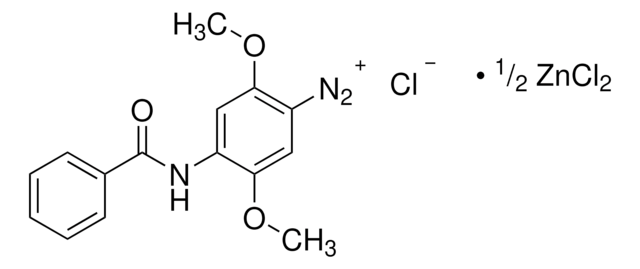202487
Poly(ethylene glycol) methyl ether
average MN 550, methoxy, hydroxyl
Sinónimos:
Polyethylene glycol monomethyl ether
About This Item
Productos recomendados
Nombre del producto
Poly(ethylene glycol) methyl ether, average Mn 550
densidad de vapor
>1 (vs air)
presión de vapor
0.05 mmHg ( 20 °C)
Formulario
semisolid
mol peso
average Mn 550
índice de refracción
n20/D 1.455
viscosidad
7.5 cSt(210 °F)(lit.)
temperatura de transición
Tm 20 °C
densidad
1.089 g/mL at 25 °C
Ω-final
hydroxyl
α-final
methoxy
cadena SMILES
O(CCO)C
InChI
1S/C3H8O2/c1-5-3-2-4/h4H,2-3H2,1H3
Clave InChI
XNWFRZJHXBZDAG-UHFFFAOYSA-N
¿Está buscando productos similares? Visita Guía de comparación de productos
Aplicación
Poly(ethylene glycol) methyl ether-grafted polyamidoamine (PAMAM) dendrimers can be used as drug carrier systems for anticancer drugs.
Código de clase de almacenamiento
10 - Combustible liquids
Clase de riesgo para el agua (WGK)
WGK 1
Punto de inflamabilidad (°F)
359.6 °F - closed cup
Punto de inflamabilidad (°C)
182 °C - closed cup
Elija entre una de las versiones más recientes:
Certificados de análisis (COA)
¿No ve la versión correcta?
Si necesita una versión concreta, puede buscar un certificado específico por el número de lote.
¿Ya tiene este producto?
Encuentre la documentación para los productos que ha comprado recientemente en la Biblioteca de documentos.
Los clientes también vieron
Artículos
Biofouling control essential for device performance and safety; minimize accumulation of biomolecules and bioorganisms.
Progress in biotechnology fields such as tissue engineering and drug delivery is accompanied by an increasing demand for diverse functional biomaterials. One class of biomaterials that has been the subject of intense research interest is hydrogels, because they closely mimic the natural environment of cells, both chemically and physically and therefore can be used as support to grow cells. This article specifically discusses poly(ethylene glycol) (PEG) hydrogels, which are good for biological applications because they do not generally elicit an immune response. PEGs offer a readily available, easy to modify polymer for widespread use in hydrogel fabrication, including 2D and 3D scaffold for tissue culture. The degradable linkages also enable a variety of applications for release of therapeutic agents.
Designing biomaterial scaffolds mimicking complex living tissue structures is crucial for tissue engineering and regenerative medicine advancements.
Nuestro equipo de científicos tiene experiencia en todas las áreas de investigación: Ciencias de la vida, Ciencia de los materiales, Síntesis química, Cromatografía, Analítica y muchas otras.
Póngase en contacto con el Servicio técnico




